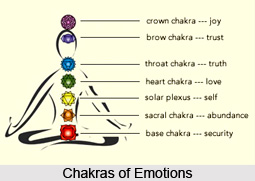 The chakras in front of the body possess smaller companion chakras on both sides, which generally have a lower flow. Their function is to help administer the amount of energy going through the central chakra and to decide how the energy is used; the ones on the right side of the body relate to attitudes or beliefs about how vigourous the chakras should be, whereas the ones on the left associate with the feeling of operation.
The chakras in front of the body possess smaller companion chakras on both sides, which generally have a lower flow. Their function is to help administer the amount of energy going through the central chakra and to decide how the energy is used; the ones on the right side of the body relate to attitudes or beliefs about how vigourous the chakras should be, whereas the ones on the left associate with the feeling of operation.
Introductory Exercise
One must be conscious of the line of central chakras and the line of companion chakras two or three inches on both sides of it. One may desire to hold one`s hands a few inches over the body, then move them down the companion chakras, first one side and then the other; it is necessary to determine which one is blocked. Companion chakras left of the belly affect the descending colon very seriously; those right of the belly influence the ascending colon. The chakras along the chest influence the lungs on both sides. Companion chakras, like the forehead area affect the left and right brain and telepathic sight.
When one discovers a blocked companion chakra, the energy must be allowed to flow out by softly massaging it and the area surrounding it. If massaging is excruciating, energy must be sent from the ends of the fingers of from the palm. Now it is time to be sit quietly, let the mind wander, and the feelings to stay open. One may come to know what had caused the hindrance in the first phase. If one fills the area with lavender, a demonstration of a curing energy which wipes out non-spiritual matters. As this exercise may undo prevailing memories and images, curing oneself may be an awesome proposal. One might wish to search for a therapist or counsellor to support oneself. It is however, not obligatory to do it all by their own self.




















